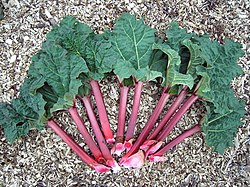
KNOWPIA
BIENVENIDOS A KNOWPIA
Summary
Emodina (de Rheum emodi, una romaza del Himalaya) es una antraquinona usada por sus propiedades laxantes en tratamientos farmacológicos, que en la actualidad incluyen una pancreatitis grave,[1][2]



Estructuras químicas
editar- 1. La 6-metil-1,3,8-trihidroxiantraquinona, de ruibarbo y de Rhamnus, incluyendo la cáscara sagrada.
- 2. Derivados de diversos aloes: una serie de principios isómeros con la emodina de ruibarbo, aloe emodina (1, 3, 8 - trihidroxyantraquinona) — una variedad de emodina de aloes de Socotora, Barbados y el archipiélago de Zanzíbar, pero no de los aloes de Natal.
Lista de plantas que contienen Emodina
editar- Senna obtusifolia[3] (syn. Cassia obtusifolia[4])
- Fallopia japonica[5] (syn. Polygonum cuspidatum[6])
- Ventilago madraspatana[7]
- Kalimeris indica[8]
- Rumex nepalensis[9]
- Polygonum hypoleucum[10]
- Cassia occidentalis[11]
- Cassia siamea[12]
- Acalypha australis[13]
- Rheum palmatum[14]
- Rhamnus purshiana[15]
- Rhamnus petiolaris[16]
Referencias
editar- Dorland's Medical Dictionary (1938)
- ↑ http://www.pubmedcentral.nih.gov/picrender.fcgi?artid=2220032&blobtype=pdf
- ↑ «Copia archivada». Archivado desde el original el 21 de septiembre de 2012. Consultado el 2 de noviembre de 2008.
- ↑ Dr. Duke's Phytochemical and Ethnobotanical Databases
- ↑ Yang, Y.-C.; Lim, M.-Y.; Lee, H.-S. (2003). «Emodin Isolated from Cassia obtusifolia (Leguminosae) Seed Shows Larvicidal Activity against Three Mosquito Species». Journal of Agricultural and Food Chemistry 51 (26): 7629-7631. PMID 14664519. doi:10.1021/jf034727t.
- ↑ «Copia archivada». Archivado desde el original el 16 de junio de 2013. Consultado el 26 de octubre de 2013.
- ↑ Ban, S. H.; Kwon, Y. R.; Pandit, S.; Lee, Y. S.; Yi, H. K.; Jeon, J. G. (2010). «Effects of a Bio-Assay Guided Fraction from Polygonum cuspidatum Root on the Viability, Acid Production and Glucosyltranferase of mutans streptococci». Fitoterapia 81 (1): 30-34. PMID 19616082. doi:10.1016/j.fitote.2009.06.019.
- ↑ Ghosh, S.; Das Sarma, M.; Patra, A.; Hazra, B. (2010). «Anti-Inflammatory and Anticancer Compounds Isolated from Ventilago madraspatana Gaertn., Rubia cordifolia Linn. and Lantana camara Linn.». Journal of Pharmacy & Pharmacology 62 (9): 1158-1166. PMID 20796195. doi:10.1111/j.2042-7158.2010.01151.x.
- ↑ Wang, G.; Wang, G. K.; Liu, J. S.; Yu, B.; Wang, F.; Liu, J. K. (2010). «[Studies on the chemical constituents of Kalimeris indica]» [Studies on the Chemical Constituents of Kalimeris indica]. Zhong Yao Cai (en chino) 33 (4): 551-554. PMID 20845783.
- ↑ Gautam, R.; Karkhile, K. V.; Bhutani, K. K.; Jachak, S. M. (2010). «Anti-Inflammatory, Cyclooxygenase (COX)-2, COX-1 Inhibitory, and Free Radical Scavenging Effects of Rumex nepalensis». Planta Medica 76 (14): 1564-1569. PMID 20379952. doi:10.1055/s-0030-1249779.
- ↑ Chao, P. M.; Kuo, Y. H.; Lin, Y. S.; Chen, C. H.; Chen, S. W.; Kuo, Y. H. (2010). «The Metabolic Benefits of Polygonum hypoleucum Ohwi in HepG2 Cells and Wistar Rats under Lipogenic Stress». Journal of Agricultural and Food Chemistry 58 (8): 5174-5180. PMID 20230058. doi:10.1021/jf100046h.
- ↑ Yadav, J. P.; Arya, V.; Yadav, S.; Panghal, M.; Kumar, S.; Dhankhar, S. (2010). «Cassia occidentalis L.: A Review on its Ethnobotany, Phytochemical and Pharmacological Profile». Fitoterapia 81 (4): 223-230. PMID 19796670. doi:10.1016/j.fitote.2009.09.008.
- ↑ Nsonde Ntandou, G. F.; Banzouzi, J. T.; Mbatchi, B.; Elion-Itou, R. D.; Etou-Ossibi, A. W.; Ramos, S.; Benoit-Vical, F.; Abena, A. A.; Ouamba, J. M. (2010). «Analgesic and Anti-Inflammatory Effects of Cassia siamea Lam. Stem Bark Extracts». Journal of Ethnopharmacology 127 (1): 108-111. PMID 19799981. doi:10.1016/j.jep.2009.09.040.
- ↑ Wang, X. L.; Yu, K. B.; Peng, S. L. (2008). «[Chemical constituents of aerial part of Acalypha australis]» [Chemical Constituents of Aerial Part of Acalypha australis]. Zhongguo Zhong Yao Za Zhi [China Journal of Chinese Materia Medica] (en chino) 33 (12): 1415-1417. PMID 18837345.
- ↑ Liu, A.; Chen, H.; Wei, W.; Ye, S.; Liao, W.; Gong, J.; Jiang, Z.; Wang, L.; Lin, S. (2011). «Antiproliferative and Antimetastatic Effects of Emodin on Human Pancreatic Cancer». Oncology Reports 26 (1): 81-89. PMID 21491088. doi:10.3892/or.2011.1257.
- ↑ Roberto Liddell. «La Cáscara Sagrada y el Cáncer: La Emodina». Archivado desde el original el 3 de agosto de 2020. Consultado el 30 de abril de 2019.
- ↑ Deveoglu, Ozan, Gokhan Erkan, Emine Torgan, and Recep Karadag (2013). «The Evaluation of Procedures for Dyeing Silk with Buckthorn and Walloon Oak on the Basis of Colour Changes and Fastness Characteristics». Coloration Technology 129 (3): 223-31. doi:10.1111/cote.12023.


